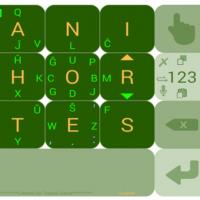Žinutės: 53
Kalba: English
Urho (Rodyti profilį) 2012 m. sausis 2 d. 18:22:48
cFlat7 (Rodyti profilį) 2012 m. sausis 2 d. 19:08:57
erinja:I like the x-method with Tajpi because I don't have to be changing keyboard layouts all the time. I can type one e-mail in Esperanto and the next in English without worrying about switching keyboards, or both languages in one text (frequent when I'm correcting lessons).Thanks for this. I have been using EK for a long time but I like this approach with Tajpi much better. I will now need to retrain my fingers to use X as in some cases as I had been using H with EK.
It works well with English because ux is usually the only instance where English collides with the Esperanto x-system. And no big deal, I just hit a second x and I get ux instead of ŭ.
As an added bonus, in situations where I might need to type in the x-method (like on a computer without an Esperanto typing application installed) it feels completely natural, because I type with the x-method anyway.
Different strokes for different folks I guess, I suppose some people don't mind switching keyboards all the time.
erinja (Rodyti profilį) 2012 m. sausis 2 d. 20:22:50
cFlat7:Thanks for this. I have been using EK for a long time but I like this approach with Tajpi much better.It should be that double x takes away the circumflex in Ek! as well, my typing hasn't changed from the time I used Ek!.
The programs are functionally extremely similar. But Tajpi is more modern, and I believe that Tajpi works in more operating systems. Tajpi also offers the choice of an interface in English or Esperanto, so for beginners who don't yet speak Esperanto well, Tajpi is easier to install and choose your settings.
Urho (Rodyti profilį) 2012 m. sausis 2 d. 21:38:40
cFlat7:Thanks for this. I have been using EK for a long time but I like this approach with Tajpi much better. I will now need to retrain my fingers to use X as in some cases as I had been using H with EK.I recommend "EK" program with a comma (,). Type:
, and c => ĉ
, and s => ŝ
, and g => ĝ
and so on.
Chainy (Rodyti profilį) 2012 m. sausis 3 d. 07:43:55
Urho:@Chainy: see also [url= http://blogo.ikso.net/2008/10/esperantaj-klavaroj-...] Esperantaj klavaroj por Mac OS X[/url] and if you know the Finnish language see ÅUIOGX keyboard layout (or FUIOGX keyboard layout).Thanks, Urho. Yes, that seems to be a good x-system keyboard for the Swedish/Finish layout.
By the way, I finished making a QWERTZ x-system keyboard for Mac computers yesterday - it can be found here, along with installation instructions in German and Esperanto.
I'll probably make another one for AZERTY keyboards soon. It's quite easy to do with the Ukelele programme on the Mac.
Chainy (Rodyti profilį) 2012 m. sausis 3 d. 08:52:33
Chainy:I'll probably make another one for AZERTY keyboards soon. It's quite easy to do with the Ukelele programme on the Mac.In fact, here you go, an AZERTY version (only for Apple Mac computers): Esperanto-iksoj_FR.bundle.zip
Fenris_kcf (Rodyti profilį) 2012 m. sausis 3 d. 11:45:01
Vestitor:Why all the hassle in Ubuntu? Just add 'Eso' from the drop-down box, to the keyboard layouts. Which can then be switched between any other languages one is using by a mouse click on the top panel (task-bar)
Then install IBus from the repository.
All the special characters are on the unused letters: q(ŝ), w(ĝ), y(ŭ), x(ĉ), [(ĵ)/quote]IMO using an Esperanto-keyboard-layout is more "a hassle" than just using a Mod-key (like ALT_GR) or a program like Ek!
Actually one has to create a layout for every region, that has its own layout already, because everybody want's to have the other keys (special characters) right there, where they were before. Having QWERTY for all regions is no option in my opinion.
Chainy (Rodyti profilį) 2012 m. sausis 3 d. 12:07:20
Fenris_kcf:IMO using an Esperanto-keyboard-layout is more "a hassle" than just using a Mod-key (like ALT_GR) or a program like Ek!I suppose it depends on whether you look at things from the perspective of the end-user, or from the perspective of the person creating the layouts! (although this doesn't have to be such a daunting task - it just takes one person per language group to make the effort).
Actually one has to create a layout for every region, that has its own layout already, because everybody want's to have the other keys (special characters) right there, where they were before. Having QWERTY for all regions is no option in my opinion.
As far as I'm aware, the standard Ubuntu (linux) Esperanto keyboard layout follows the QWERTY pattern. But, it's perfectly possible to create alternative versions. Ok, bit of a hassle initially perhaps, but once they are all set up, it's just a matter of people picking the one they like.
Chainy (Rodyti profilį) 2012 m. sausis 3 d. 12:11:30
It would be great if some people could test these. They work perfectly fine on my computer (Mac OS X 10.4 Tiger), and I don't see any reason why they shouldn't work on newer versions of Mac OS X, but you never know.
erinja (Rodyti profilį) 2012 m. sausis 3 d. 14:59:11
Fenris_kcf:IMO using an Esperanto-keyboard-layout is more "a hassle" than just using a Mod-key (like ALT_GR) or a program like Ek!I agree. But some people prefer to have a keyboard layout, so it's still worth the trouble to create the layouts, because there is clearly demand for them.



